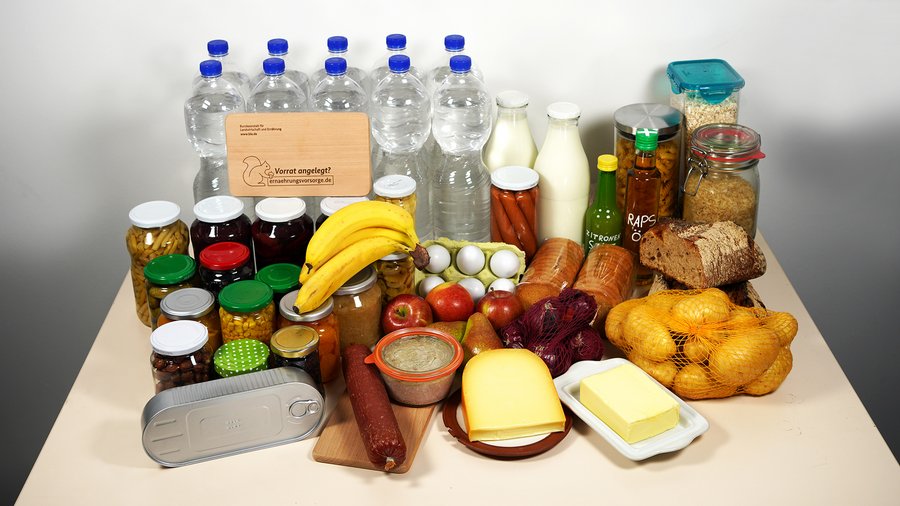Wir verwenden Cookies, um Ihnen die optimale Nutzung unserer Webseite zu ermöglichen. Es werden für den Betrieb der Seite nur notwendige Cookies gesetzt. Details in unserer Datenschutzerklärung.
Hier beginnt der Hauptinhalt dieser Seite
This web page aims to make it easier for interested citizens to access information about food preparedness and to inform them about tasks, responsibilities and government activities in this area.
In addition to war scenarios, there are also numerous peacetime crisis situations that may lead to a shortage of food and thus to supply bottlenecks. These include, for example, animal diseases or serious accidents in large-scale technical installations.
The following sections will provide you with information about what the state is doing to ensure that the population is supplied with food in an emergency and how you can take your own private precautions to contribute to your food supply in emergency situations.
Within the framework of general public services, the German government has created a statutory basis that allows it to control the supply of food in extraordinary circumstances. State food preparedness helps to bridge supply bottlenecks in crisis situations in the short term. However, it requires a supplementary accumulation of provisions in private households.
In the Federal Republic of Germany, the federal government has, on the basis of its supply policy, set up state food reserves whose quantity does not fluctuate over the year. It is only possible to respond quickly to shortcomings in the supply when there are provisions that are available at any time in the event of a crisis. On the one hand, more extensive provisions are often not available in agri-food establishments and the food trade; on the other hand, certain agricultural products cannot be produced from a standing start due to the natural growing and harvesting cycles. In the context of the national crisis provisions, which the Federal Office of Food and Agriculture (BLE) is responsible for buying, selling and monitoring, the Civic Emergency Reserve and the National Reserve of Cereals store food.
Civic Emergency Reserve
The Civic Emergency Reserve consists of rice (long and round grain), pulses (peas and lentils) and condensed milk. This safety reserve of basic foodstuffs aims to contribute towards supplying the population with at least one meal per day in crisis situations, especially in urban centres.
The National Reserve of Cereals
The National Reserve of Cereals consists of bread cereals (wheat, rye) and oats. Its aim is to maintain the supply of flour and bread in a crisis. These reserves are stored near mills because of the necessary further processing.

In this day and age, there are good reasons for building up your own stock of food provisions. Firstly, private provisions give you a personal security of supply in times of crisis – this may be an extended power cut or being cut off from the food supply because of floods or snow. Secondly, private provisions also provide advantages in your normal everyday life. Therefore, household food provisions are a practical reserve. Stockpiling also saves time and money when you can take advantage of special offers for large purchases.
Emergency provisions
It is extremely advisable to always have food provisions for a period of 10 days in your house. This means that you and your family are not left with an empty stomach in an emergency. When planning your individual accumulation of provisions, consider the eating habits, tastes and dietary requirements of the members of your family. Then you will be optimally equipped for all eventualities.
Below, we have compiled examples of a 10-day stock of basic provisions for one person. These correspond to approximately 2,200 kcal per day and thus cover all your energy and nutritional needs.





Detailed table of provisions for a mixed diet
Detailed table of provisions for a vegetarian diet
Recommendations and tips for emergency provisions
Consider what premises you have at your disposal for the storage of provisions (e.g. pantry, cellar, shelves in the garage). What storage capacity do your refrigerators and freezers provide? What alternatives are there in the event of a power cut?
How many people need to be supplied with food? The ages, activity and any dietary requirements of the members of the household must be taken into consideration. Keeping provisions is only sensible if they are going to be used on a regular basis. The eating habits and the personal tastes of the members of the household should always be taken into consideration in the composition of the provisions.
Remember that there may also be a power cut or a failure of the water supply in the event of a crisis situation. Therefore, every balanced stock of emergency provisions should include sufficient quantities of drinking water and food that can be consumed cold if necessary. Alternative cooking facilities, e.g. a camp stove, are also helpful for heating food and water in the event of a power cut or a failure of the gas supply.
You can find further information on precautions and ways of helping yourself in the brochure published by the Federal Office of Civil Prevention and Disaster Assistance (BBK):
Guide for Emergency Preparedness and Correct Action in Emergency Situations